#the Dakota 38
Text
"One trader named Andrew Myrick is famous for his refusal to provide credit to Dakota people by saying, 'If they are hungry, let them eat grass.' // There are variations of Myrick’s words, but they are all something to that effect. // When settlers and traders were killed during the Sioux Uprising, one of the first to be executed by the Dakota was Andrew Myrick. // When Myrick’s body was found, / his mouth was stuffed with grass. // I am inclined to call this act by the Dakota warriors a poem."
Read it here | Reblog for a larger sample size!
#closed polls#polls#poetry#poems#poetry polls#poets and writing#tumblr poetry#have you read this#sometimes we get extra options as a treat#38#layli long soldier#38 layli long soldier#the dakota 38#the sioux uprising#admin faves
11 notes
·
View notes
Text
38 // Layli Long Soldier
Here, the sentence will be respected.
I will compose each sentence with care, by minding what the rules of writing dictate.
For example, all sentences will begin with capital letters.
Likewise, the history of the sentence will be honored by ending each one with appropriate punctuation such as a period or question mark, thus bringing the idea to (momentary) completion.
You may like to know, I do not consider this a “creative piece.”
I do not regard this as a poem of great imagination or a work of fiction.
Also, historical events will not be dramatized for an “interesting” read.
Therefore, I feel most responsible to the orderly sentence; conveyor of thought.
That said, I will begin.
You may or may not have heard about the Dakota 38.
If this is the first time you’ve heard of it, you might wonder, “What is the Dakota 38?”
The Dakota 38 refers to thirty-eight Dakota men who were executed by hanging, under orders from President Abraham Lincoln.
To date, this is the largest “legal” mass execution in US history.
The hanging took place on December 26, 1862—the day after Christmas.
This was the same week that President Lincoln signed the Emancipation Proclamation.
In the preceding sentence, I italicize “same week” for emphasis.
There was a movie titled Lincoln about the presidency of Abraham Lincoln.
The signing of the Emancipation Proclamation was included in the film Lincoln; the hanging of the Dakota 38 was not.
In any case, you might be asking, “Why were thirty-eight Dakota men hung?”
As a side note, the past tense of hang is hung, but when referring to the capital punishment of hanging, the correct past tense is hanged.
So it’s possible that you’re asking, “Why were thirty-eight Dakota men hanged?”
They were hanged for the Sioux Uprising.
I want to tell you about the Sioux Uprising, but I don’t know where to begin.
I may jump around and details will not unfold in chronological order.
Keep in mind, I am not a historian.
So I will recount facts as best as I can, given limited resources and understanding.
Before Minnesota was a state, the Minnesota region, generally speaking, was the traditional homeland for Dakota, Anishinaabeg, and Ho-Chunk people.
During the 1800s, when the US expanded territory, they “purchased” land from the Dakota people as well as the other tribes.
But another way to understand that sort of “purchase” is: Dakota leaders ceded land to the US government in exchange for money or goods, but most importantly, the safety of their people.
Some say that Dakota leaders did not understand the terms they were entering, or they never would have agreed.
Even others call the entire negotiation “trickery.”
But to make whatever-it-was official and binding, the US government drew up an initial treaty.
This treaty was later replaced by another (more convenient) treaty, and then another.
I’ve had difficulty unraveling the terms of these treaties, given the legal speak and congressional language.
As treaties were abrogated (broken) and new treaties were drafted, one after another, the new treaties often referenced old defunct treaties, and it is a muddy, switchback trail to follow.
Although I often feel lost on this trail, I know I am not alone.
However, as best as I can put the facts together, in 1851, Dakota territory was contained to a twelve-mile by one-hundred-fifty-mile long strip along the Minnesota River.
But just seven years later, in 1858, the northern portion was ceded (taken) and the southern portion was (conveniently) allotted, which reduced Dakota land to a stark ten-mile tract.
These amended and broken treaties are often referred to as the Minnesota Treaties.
The word Minnesota comes from mni, which means water; and sota, which means turbid.
Synonyms for turbid include muddy, unclear, cloudy, confused, and smoky.
Everything is in the language we use.
For example, a treaty is, essentially, a contract between two sovereign nations.
The US treaties with the Dakota Nation were legal contracts that promised money.
It could be said, this money was payment for the land the Dakota ceded; for living within assigned boundaries (a reservation); and for relinquishing rights to their vast hunting territory which, in turn, made Dakota people dependent on other means to survive: money.
The previous sentence is circular, akin to so many aspects of history.
As you may have guessed by now, the money promised in the turbid treaties did not make it into the hands of Dakota people.
In addition, local government traders would not offer credit to “Indians” to purchase food or goods.
Without money, store credit, or rights to hunt beyond their ten-mile tract of land, Dakota people began to starve.
The Dakota people were starving.
The Dakota people starved.
In the preceding sentence, the word “starved” does not need italics for emphasis.
One should read “The Dakota people starved” as a straightforward and plainly stated fact.
As a result—and without other options but to continue to starve—Dakota people retaliated.
Dakota warriors organized, struck out, and killed settlers and traders.
This revolt is called the Sioux Uprising.
Eventually, the US Cavalry came to Mnisota to confront the Uprising.
More than one thousand Dakota people were sent to prison.
As already mentioned, thirty-eight Dakota men were subsequently hanged.
After the hanging, those one thousand Dakota prisoners were released.
However, as further consequence, what remained of Dakota territory in Mnisota was dissolved (stolen).
The Dakota people had no land to return to.
This means they were exiled.
Homeless, the Dakota people of Mnisota were relocated (forced) onto reservations in South Dakota and Nebraska.
Now, every year, a group called the Dakota 38 + 2 Riders conduct a memorial horse ride from Lower Brule, South Dakota, to Mankato, Mnisota.
The Memorial Riders travel 325 miles on horseback for eighteen days, sometimes through sub-zero blizzards.
They conclude their journey on December 26, the day of the hanging.
Memorials help focus our memory on particular people or events.
Often, memorials come in the forms of plaques, statues, or gravestones.
The memorial for the Dakota 38 is not an object inscribed with words, but an act.
Yet, I started this piece because I was interested in writing about grasses.
So, there is one other event to include, although it’s not in chronological order and we must backtrack a little.
When the Dakota people were starving, as you may remember, government traders would not extend store credit to “Indians.”
One trader named Andrew Myrick is famous for his refusal to provide credit to Dakota people by saying, “If they are hungry, let them eat grass.”
There are variations of Myrick’s words, but they are all something to that effect.
When settlers and traders were killed during the Sioux Uprising, one of the first to be executed by the Dakota was Andrew Myrick.
When Myrick’s body was found,
his mouth was stuffed with grass.
I am inclined to call this act by the Dakota warriors a poem.
There’s irony in their poem.
There was no text.
“Real” poems do not “really” require words.
I have italicized the previous sentence to indicate inner dialogue, a revealing moment.
But, on second thought, the words “Let them eat grass” click the gears of the poem into place.
So, we could also say, language and word choice are crucial to the poem’s work.
Things are circling back again.
Sometimes, when in a circle, if I wish to exit, I must leap.
And let the body swing.
From the platform.
Out
to the grasses.
#poetry#Layli Long Soldier#Indigenous poetry#Dakota#the Dakota 38#Minnesota#Indigenous history#America#circling
14 notes
·
View notes
Text


The Dakota 38 [+ 2], Mankato, Friday, December 26, 1862 [Minnesota Historical Society, St. Paul, MN]
(images: excerpts from A Detailed Account of the Massacre by the Dakota Indians of Minnesota in 1862, Marion P. Satterlee, Minneapolis, MN, 1923, pp. 94-95. Library of Congress, Washington, D.C.)


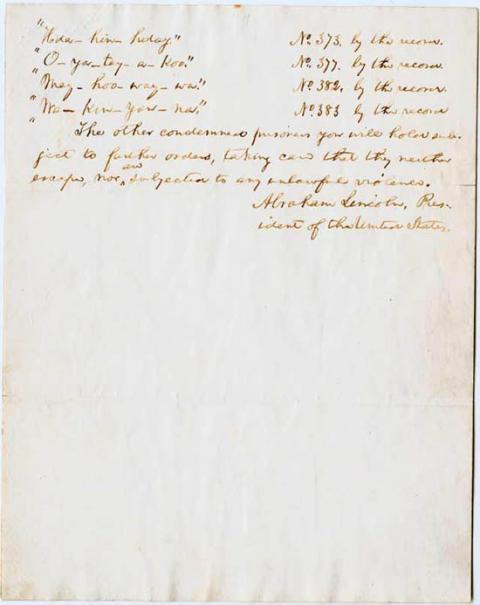
«On November 8, after completing harried trials of Dakota prisoners taken after their surrender at Camp Release, Henry Sibley presented the list of 303 condemned Dakota men to the US government.
Two days later, President Lincoln wired Gen. John Pope, Sibley’s superior: "Please forward, as soon as possible, the full and complete record of these convictions."
Lincoln and his lawyers then reviewed the trial transcripts of all 303 men. "Anxious to not act with so much clemency as to encourage another outbreak on one hand," Lincoln explained to the US Senate, "nor with so much severity as to be real cruelty on the other, I ordered a careful examination of the records of the trials to be made, in view of first ordering the execution of such as had been proved guilty of violating females." When only two men were found guilty of rape, Lincoln expanded the criteria to include those who had participated in "massacres" of civilians rather than "battles." He then made his final decision, and forwarded a list of 39 names to Sibley.
Ordered that of the Indians and Half-breeds sentenced to be hanged by the military commission, composed of Colonel Crooks, Lt. Colonel Marshall, Captain Grant, Captain Bailey, and Lieutenant Olin, and lately sitting in Minnesota, you cause to be executed on Friday the nineteenth day of December, instant, the following names, to wit [39 names listed by case number of record: cases 2, 4, 5, 6, 10, 11, 12, 14, 15, 19, 22, 24, 35, 67, 68, 69, 70, 96, 115, 121, 138, 155, 170, 175, 178, 210, 225, 254, 264, 279, 318, 327, 333, 342, 359, 373, 377, 382, 383]. The other condemned prisoners you will hold subject to further orders, taking care that they neither escape, nor are subjected to any unlawful violence. Abraham Lincoln, President of the United States».
– Minnesota Historical Society
#graphic design#history#manuscript#correspondence#book#dakota 38#marion p. satterlee#abraham lincoln#henry sibley#1860s
27 notes
·
View notes
Text
38
Here, the sentence will be respected.
I will composed each sentence with care by minding what the rules of writing dictate.
For example, all sentences will begin with capital letters.
Likewise, the history of the sentence will be honored by ending each one with appropriate punctuation such as a period or a question mark, thus bringing the idea to (momentary) completion.
You may like to know, I do not consider this a “creative piece.”
I do not regard this as a poem of great imagination or a work of fiction.
Also, historical events will not be dramatized for an interesting read.
Therefore, I feel most responsible to the orderly sentence; conveyor of thought.
That said, I will begin.
You may or may not have heard about the Dakota 38.
If this is the first time you've heard of it, you might wonder, “What is the Dakota 38?”
“The Dakota 38” refers to the thirty-eight Dakota men who were executed by hanging, under orders from President Abraham Lincoln.
To date, this is the largest “legal” mass execution in U.S. history.
The hanging took place on December 26th, 1862—the day after Christmas.
This was the same week that President Lincoln signed The Emancipation Proclamation.
In the preceding sentence, I italicize “same week” for emphasis.
There was a movie titled Lincoln about the presidency of Abraham Lincoln.
The signing of The Emancipation Proclamation was included in the film Lincoln; the hanging of the Dakota 38 was not.
In any case, you might be asking, “Why were thirty-eight Dakota men hung?”
As a side note, the past tense of hang is hung, but when referring to the capital punishment of hanging, the correct tense is hanged.
So it's possible that you're asking, “Why were thirty-eight Dakota men hanged?”
They were hanged for The Sioux Uprising.
I want to tell you about The Sioux Uprising, but I don't know where to begin.
I may jump around and details will not unfold in chronological order.
Keep in mind, I am not a historian.
So I will recount facts as best I can, given limited resources and understanding.
Before Minnesota was a state, the Minnesota region, generally speaking, was the traditional homeland for Dakota, Anishinaabeg and Ho-Chunk people.
During the 1800s, when the U.S. expanded territory, they “purchased” land from the Dakota people a well as the other tribes.
But another way to understand the sort of “purchase” is: Dakota leaders ceded land to the U.S. Government in exchange for money and goods, but most importantly, the safety of their people.
Some say that Dakota leaders did not understand the terms they were entering, or they never would have agreed.
Even others call the entire negotiation, “trickery.”
But to make whatever-it-was official and binding the U.S. Government drew up an initial treaty.
This treaty was later replaced by another (more convenient) treaty, and then another.
I've had difficulty unraveling the terms of these treaties, given the legal speak and congressional language.
As treaties were abrogated (broken) and new treaties were drafted, one after another, the new treaties often referenced old defunct treaties and it is a muddy, switchback trail to follow.
Although I often feel lost on this trail, I know I am not alone.
However, as best as I can put the facts together, in 1851, Dakota territory was contained to a twelve-mile by one-hundred-fifty-mile-long strip along the Minnesota river.
But just seven years later, in 1858, the northern portion was ceded (taken) and the southern portion was (conveniently) allotted, which reduced Dakota land to a stark ten-mile tract.
These amended and broken treaties are often referred to as The Minnesota Treaties.
The word Minnesota comes from mni which means water; sota which means turbid.
Synonyms for turbid include muddy, unclear, cloudy, confused and smoky.
Everything is in the language we use.
For example, a treaty is, essentially, a contract between two sovereign nations.
The U.S. treaties with the Dakota Nation were legal contracts that promised money.
It could be said, this money was payment for the land the Dakota ceded; for living within assigned boundaries (a reservation); and for relinquishing rights to their vast hunting territory which, in turn, made Dakota people dependent on other means to survive; money.
The previous sentence is circular, which is akin to so many aspects of history.
As you may have guessed by now, the money promised in the turbid treaties did not make it into the hands of the Dakota people.
In addition, local government traders would not offer credit to “Indians” to purchase food or goods.
Without money, store credit or rights to hunt beyond their ten-mile tract of land, Dakota people began to starve.
The Dakota people were starving.
The Dakota people starved.
In the preceding sentence, the word “starved” does not need italics for emphasis.
One should read, “The Dakota people starved,” as a straightforward and plainly stated fact.
As a result—and without other options but to continue to starve—Dakota people retaliated.
Dakota warriors organized, struck out and killed settlers and traders.
This revolt is called The Sioux Uprising.
Eventually, the U.S. Cavalry came to Mnisota to confront the Uprising.
More than one thousand Dakota people were sent to prison.
As already mentioned, thirty-eight Dakota men were subsequently hanged.
After the hanging, those one thousand Dakota prisoners were released.
However, as further consequence, what remained fo Dakota territory in Mnisota was dissolved (stolen).
The Dakota people had no land to return to.
This means they were exiled.
Homeless, the Dakota people of Mnisota were relocated (forced) onto reservations in South Dakota and Nebraska.
Now, every year, a group called The Dakota 38 + 2 Riders conduct a memorial horse rider from Lower Brule, South Dakota to Mankato, Mnisota.
The Memorial Riders travel 325 miles on horseback for eighteen days, sometimes through sub-zero blizzards.
They conclude their journey on December 26, the day of the hanging.
Memorials help focus our memory on particular people or events.
Often, memorials come in the forms of plaques, statues or gravestones.
The memorial for the Dakota 38 is not an object inscribed with words, but an act.
Yet, I started this piece because I was interested in writing about grasses.
So, there is one other event to include, although it's not in chronological order and we must backtrack a little.
When the Dakota people were starving, as you may remember, government traders would not extend store credit to “Indians.”
One trader named Andrew Myrick is famous for his refusal to provide credit to Dakotas by saying, “If they are hungry, let them eat grass.”
There are variations on Myrick's words, but they are all something to that effect.
When settlers and traders were killed during the Sioux Uprising, one of the first to be executed by the Dakota was Andrew Myrick.
When Myrick's body was found, his mouth was stuffed with grass.
I am inclined to call this act by the Dakota warriors a poem.
There's irony in their poem.
There was no text.
“Real” poems do not “really” require words.
I have italicized the previous sentence to indicate inner dialogue, a revealing moment.
But, on second thought, the particular words "Let them eat grass" click the gears of the poem into place.
So, we could also say, language and word choice are crucial to the poem's work.
Things are circling back again.
Sometimes, when in a circle, if I wish to exit, I must leap.
And let the body swing.
From the platform.
Out
to the grasses.
— Layli Long Soldier (1973–)
When the Light of the World Was Subdued, Our Songs Came Through: A Norton Anthology of Native Nations Poetry (2020)
#Layli Long Soldier#38#Dakota 38#Native American#poem#poet#poetry#history#American history#When the Light of the World Was Subdued Our Songs Came Through
19 notes
·
View notes
Text
0 notes
Text


12 | 38
Next: here
Oh boy I wonder if Dakota's finally gonna throw hands
Fun extra fact: I wanted to include a panel of Dakota sitting on the floor and holding Charlie's hand cause he didn't wanna overstep any boundries buuut I figured it'll be a piece of art I'll make for later > v •
#smiling critters#smiling critters au#catnap#poppy playtime#dogday#digital art#catnap x dogday#dogday x catnap#smiling critters oc#smiling critters university au
201 notes
·
View notes
Text
Jude's Timeline
Since there are no dates or determinable time period (beyond the fact that it's set in the 21st century) in A Little Life, I love trying to figure out the timelines of the characters themselves. So here's Jude.
Newborn
Born in South Dakota
Abandoned as a newborn and taken in by the monastery
5 years old
Received a fossil from Brother Luke for his birthday
7 years old
Had his hand burnt by Father Gabriel
Sexual abuse by the Brothers began
8 years old
Given a set of wooden logs for his birthday
Abducted by Brother Luke and forced into prostitution
11 years old
Began cutting himself
12 years old
Rescued from Brother Luke
Placed in a boys group home in Montana
13 years old
Meets the Learys
Beaten by the counselors, causing life-long scarring on his back
14 years old
Runs away from the group home in Montana
Abducted by Dr. Traylor and held captive for four months
15 years old
Run over by Dr. Traylor, causing his life-long disability
Rescued from Dr. Traylor
Meets Ana
Begins living with the Douglasses
16 years old
Ana passes away
Briefly lives in an emergency shelter
Has a summer job at a bakery
Leaves Philadelphia, and starts his undergraduate study at an unnamed college in Boston
17 years old
Met Andy Contractor
Gifted a model house by Malcolm
18 years old
Began working as a classics professor's amanuensis
Dr. Traylor dies in prison
20 years old
Graduated from his undergraduate study and goes to France for the first time
Began Law School at (presumably) Harvard
Began his Pure Math Master's degree from MIT
Met Harold Stein and Julia Altman
21 years old
Stayed at Harold and Julia's house for the first time and imagined they were his parents
Had an unspecified internship during the summer
Invited to Harold and Julia's summer house, Truro, for the first time
22 years old
Learned to drive (from Harold)
23 years old
Graduated Law School
Graduated Masters at MIT
Began his clerkship in Washington, living in the living room of an unnamed legislative assistant
24 years old
Given keys to the Cambridge house by Julia
25 years old
Moved to New York, living at Malcolm's parents' house
Began working at the U.S Attorney as an assistant prosecutor
Moved out of Malcom's parents' house to Lispenard St
26 years old
Has his first episode in front of Harold, who sings to him
Willem finds out about his cutting
Jumps off a roof with his friends at Lispenard St
27 years old
Broke the mug that Jacob made
Attended Andy's wedding
29 years old
Began tutoring Felix
30 years old
Adopted by Harold and Julia <3
31 years old
First contacted by Lucien after working on case for Thackery Smith
Finalized the contract for a job at Rosen Pritchard, after the elevator broke once more at Lispenard
Contacted by Rob Wilson (Some unknown from the home)
32 years old
Bought his Green Street apartment
35 years old
Became a partner at Rosen Pritchard (the youngest one in the firm's history)
36 years old
Picked out a suit for Malcolm for his wedding that would happen that year
Began the renovations for Greene Street
37 years old
Broke off his friendship with JB after the latter mocks his disability
38 years old
Scolded by Harold out at dinner for working at Rosen Pritchard
40 years old
His former Master's advisor, Dr. Kashen, passes away
Attended his former classmates, Lionel and Sinclair's, wedding
Began dating Caleb Porter
Broke up with Caleb Porter
41 years old
Attempts suicide and is briefly institutionalized
Goes to Morroco
43 years old
Caleb port a potty dies <3
Began dating Willem
45 years old
Has his big fight with Willem and tells him about his childhood
46 years old
Buys a flat in London on Harley Street
The last time he would truly walk on his own. No aides, no prosthetics. This is during a trip to Bhutan
47 years old
Starts getting lots of wounds on his legs and bone infections
48 years old
Gets his legs amputated
49 years old
Starts walking again
50 years old
Set up scholarships for Julia and Harold at their respective universities
Loses both Willem and Malcolm (and Sophie) to a drunk driving accident
51 years old
His loved ones hold an intervention for him
52 years old
Went to Rome
Taught Harold how to cook
Asked to be the chairman of Rosen Pritchard
53 years old
Took his own life :(
If there's anything here you think should be added let me know. And of course this isn't every single thing that happened to Jude, just some main events or events that helped pinpoint the timeline. So if there's a scene/event/anything that you'd like to know the timeline of, let me know (inbox)
85 notes
·
View notes
Text
Native Tribe To Get Back Land 160 Years After Largest Mass Hanging In US History
Upper Sioux Agency state park in Minnesota, where bodies of those killed after US-Dakota war are buried, to be transferred
— Associated Press | Sunday 3 September, 2023

The Upper Sioux Agency State Park near Granite Falls, Minnesota. Photograph: Trisha Ahmed/AP
Golden prairies and winding rivers of a Minnesota state park also hold the secret burial sites of Dakota people who died as the United States failed to fulfill treaties with Native Americans more than a century ago. Now their descendants are getting the land back.
The state is taking the rare step of transferring the park with a fraught history back to a Dakota tribe, trying to make amends for events that led to a war and the largest mass hanging in US history.
“It’s a place of holocaust. Our people starved to death there,” said Kevin Jensvold, chairman of the Upper Sioux Community, a small tribe with about 550 members just outside the park.
The Upper Sioux Agency state park in south-western Minnesota spans a little more than 2 sq miles (about 5 sq km) and includes the ruins of a federal complex where officers withheld supplies from Dakota people, leading to starvation and deaths.
Decades of tension exploded into the US-Dakota war of 1862 between settler-colonists and a faction of Dakota people, according to the Minnesota Historical Society. After the US won the war, the government hanged more people than in any other execution in the nation. A memorial honors the 38 Dakota men killed in Mankato, 110 miles (177km) from the park.
Jensvold said he has spent 18 years asking the state to return the park to his tribe. He began when a tribal elder told him it was unjust Dakota people at the time needed to pay a state fee for each visit to the graves of their ancestors there.

Native American tribe in Maine buys back Island taken 160 years ago! The Passamaquoddy’s purchase of Pine Island for $355,000 is the latest in a series of successful ‘land back’ campaigns for indigenous people in the US. Pine Island. Photograph: Courtesy the writer, Alice Hutton. Friday 4 June, 2021
Lawmakers finally authorized the transfer this year when Democrats took control of the house, senate and governor’s office for the first time in nearly a decade, said State Senator Mary Kunesh, a Democrat and descendant of the Standing Rock Nation.
Tribes speaking out about injustices have helped more people understand how lands were taken and treaties were often not upheld, Kunesh said, adding that people seem more interested now in “doing the right thing and getting lands back to tribes”.
But the transfer also would mean fewer tourists and less money for the nearby town of Granite Falls, said Mayor Dave Smiglewski. He and other opponents say recreational land and historic sites should be publicly owned, not given to a few people, though lawmakers set aside funding for the state to buy land to replace losses in the transfer.
The park is dotted with hiking trails, campsites, picnic tables, fishing access, snowmobiling and horseback riding routes and tall grasses with wildflowers that dance in hot summer winds.
“People that want to make things right with history’s injustices are compelled often to support action like this without thinking about other ramifications,” Smiglewski said. “A number, if not a majority, of state parks have similar sacred meaning to Indigenous tribes. So where would it stop?”
In recent years, some tribes in the US, Canada and Australia have gotten their rights to ancestral lands restored with the growth of the Land Back movement, which seeks to return lands to Indigenous people.

‘It’s a powerful feeling’: the Indigenous American tribe helping to bring back buffalo 🦬! Matt Krupnick in Wolakota Buffalo Range, South Dakota. Sunday 20 February, 2022. The Wolakota Buffalo Range in South Dakota has swelled to 750 bison with a goal of reaching 1,200. Photograph: Matt Krupnick
A National Park has never been transferred from the US government to a tribal nation, but a handful are Co-managed with Tribes, including Grand Portage National Nonument in northern Minnesota, Canyon de Chelly National Monument in Arizona and Glacier Bay National Park in Alaska, Jenny Anzelmo-Sarles of the National Park Service said.
This will be the first time Minnesota transfers a state park to a Native American community, said Ann Pierce, director of Minnesota State Parks and trails at the natural resources department.
Minnesota’s transfer, expected to take years to finish, is tucked into several large bills covering several issues. The bills allocate more than $6m to facilitate the transfer by 2033. The money can be used to buy land with recreational opportunities and pay for appraisals, road and bridge demolition and other engineering.
Chris Swedzinski and Gary Dahms, the Republican lawmakers representing the portion of the state encompassing the park, declined through their aides to comment about their stances on the transfer.
— The Guardian USA
#Minnesota#U.S. 🇺🇸 News#World 🌎 News#Native Tribes#Land Buy Back#The Upper Sioux Agency State Park#Burial Sites of Dakota People#United States 🇺🇸 | Failed Treaties#Native Americans#Kevin Jensvold | Upper Sioux Community#US-Dakota War of 1862#Dakota Men Killed | Mankato#Minnesota Historical Society#State Senator | Mary Kunesh | Democrat | Descendant | Standing Rock Nation#Granite Falls#Mayor Dave Smiglewski#US 🇺🇸 | Canada 🍁 🇨🇦 | Australia 🇦🇺#Ancestral Lands Restored#Land Back Movements#Grand Portage National Nonument#Canyon de Chelly National Monument#Glacier Bay National Park#Ann Pierce | Minnesota State Parks#Chris Swedzinski | Gary Dahms | Republican Lawmakers
259 notes
·
View notes
Text
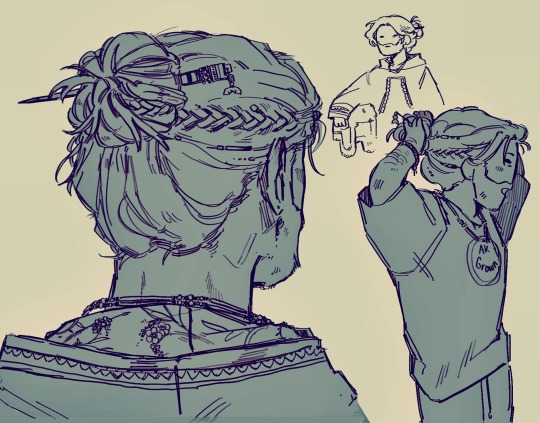
I read about Alaska native hair sticks when I was doing research on Ak native beadworks 😼 the sticks tend to be made outta whale bone, moose bone, ivory, porcupine quill, and sometimes wood... but they do have beadwork on them usually as well! Anyways I think Alaska should have at least shoulder length hair 😊 because yeah (i also added some other random beads in his hair just cuz) Also important rant that I'm passionate about:

So basically: I will elaborate on why I think Alaska should be more represented as Native Alaskan
Outta 574 federally recognized tribes in the United States, Alaska has 231 of them, and for comparison Oklahoma has 38, California has 109 (the second most), and the Dakotas (combined) have 14
over 20% of Alaska's population is Alaskan Native
Alaska has over 20 official languages that are all Indigenous languages except for English
I think, just because Alaska was owned by Russia, doesn't make him Russian, and it's kinda weird to just overlook all the tough native Alaskan history that goes back to the 1700s, and those who suffer generational trauma, and try to space away from it, just to be associated with Russia all over again
Alaska has over 270 places that have Native Alaskan names
They strongly influence Alaskan life for everyone, within architect, art, survival, storytelling, respecting nature, etc
is there really a reason why he shouldn't be represented as indigenous??
It's good to recognize all the struggles and perseverance they've been thru and still go thru, Alaska is deeper than just... was owned by Russia, now is not.
Alaska's name is indigenous, and officially has five other native Alaskan spellings
Alaska's cool sick awesome flag was made by an indigenous boy
Alaska has 300 different dialects
etc if I remember more some other time

plus Ben had looked for some Alaska native to play Alaska soo 😊 but yes, this means a lot to me; I really do wish Alaska was more represented as native, but I assume maybe you guys just dont know much about them?? So, if you have any questions about Alaska natives and the culture, I will direct you to @mothanonthesequel so it's easier for me to answer them there
#wttt#welcome to the table#welcome to the statehouse#ben brainard#wttt fan art#wttt fanart#wttt headcanons#wttt alaska#wttsh#wttsh fanart#wttsh art#wttsh alaska#wttsh headcanons#wttsh hc#wttsh fan art
126 notes
·
View notes
Photo
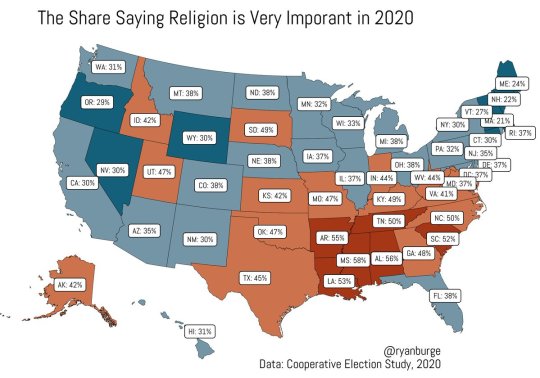
Share of each state saying religion is very important.
The variations even inside a region are notable.
Mississippi: 58% Florida: 38%
Utah: 47% Nevada: 30%
Oklahoma: 47% New Mexico: 30%
South Dakota: 49% Wyoming: 30%
by @ryanburge
147 notes
·
View notes
Text
Volcanoes
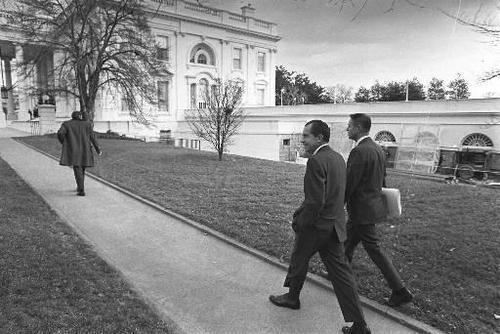
It was the crowning moment in Richard Milhous Nixon’s long career of political ups-and-downs. For the fifth time, Nixon had been a candidate on the national ticket (twice as Vice President, three times as President). In 1952 and 1956, the focus was on the top of the ticket, Nixon’s running mate, General Dwight D. Eisenhower. In 1960, Nixon narrowly lost to – and some would say was the victim of electoral theft from – John F. Kennedy. In 1968, Nixon finally won election to the Presidency, but he did so with some bitterness: the country was in shambles and the two people he wanted to oppose more than anyone else in the election – Lyndon B. Johnson and Bobby Kennedy – had respectively quit and been murdered during the turbulent campaign. Not only that, but in victory, Nixon had garnered only 43.4% of the vote – a full 6 percentage points less than he had earned in his 1960 loss to JFK.
On November 7, 1972, however, Nixon’s “Silent Majority” spoke loud and clear – and truly gave him both a majority victory and a strong mandate for his second term in the White House. Nixon trounced his opponent, Democratic Senator George S. McGovern, on election night. His popular vote victory was 61%-38% and Nixon’s margin in the Electoral College was even larger, 520-17. Nixon won every single state in the country except for Massachusetts. Nixon even won McGovern’s home state of South Dakota.
As the election returns rolled in and Nixon’s family, supporters, and staff celebrated, the man who had received the votes of 47,169,841 of his fellow Americans that day to be their President noted that he felt “a curious feeling, perhaps a foreboding, that muted my enjoyment of this triumphal moment." In his Memoirs (BOOK | KINDLE), Richard Nixon elaborated further, "I am at a loss to explain the melancholy that settled over me on that victorious night…To some extent the marring effects of Watergate may have played a part, to some extent our failure to win Congress, and to a greater extent the fact that we had not yet been able to end the war in Vietnam. Or perhaps it was because this would be my last campaign. Whatever the reasons, I allowed myself only a few minutes to reflect on the past. I was confident that a new era was about to begin, and I was eager to begin it.”
The new era began the next morning. At 12:00 PM on November 8, 1972, President Nixon gathered his Cabinet in the White House. Nixon seemed tired and was suffering from a painful toothache. National Security Adviser Henry Kissinger noted that the President seemed “grim and remote”. Nixon’s loyal Chief of Staff, H. R. “Bob” Haldeman was at his side as the President nonchalantly thanked his Cabinet and then described his recent readings about 19th Century British Prime Minister Benjamin Disraeli and how Disraeli described a need to refresh the British government and rid it of the “exhausted volcanoes” in William Gladstone’s Cabinet. Nixon’s Cabinet was perplexed and curious as to where the President was headed. He had just won a historic landslide victory in the Presidential election, but he spoke as if he had lost everything.
After a few more minutes of talking about his plans for a second term that wasn’t “lethargic” such as those of some of his predecessors, Nixon simply stood up and walked out of the Cabinet Room, headed across the South Lawn, boarded Marine One and flew to his Camp David retreat. When the President stands, everyone stands but as soon as he left the room, the Cabinet sat down and looked at Bob Haldeman, who took over the meeting. Haldeman handed pieces of paper out to the Cabinet and said, “You’re all a bunch of burned-out volcanoes”. Then he immediately demanded everyone’s resignation. Nixon had won one of the biggest victories in American electoral history, and 24 hours later, he was basically firing everyone who had helped him to do so – earlier in the day, he had done the same thing that he did to the Cabinet to his White House staff.
Henry Kissinger summed it up by saying that, “It was as if victory was not an occasion for reconciliation but an opportunity to settle the scores of a lifetime." For Richard Nixon, victory was never enough. He needed destruction. Nixon got rid of his exhausted volcanoes, but he was sitting on top of another volcano named Watergate. His abbreviated second term, which had been won the night before, would end less than two years later in his own personal and professional destruction.
#History#Richard Nixon#Presidents#President Nixon#Nixon Administration#Cabinet of Richard Nixon#Nixon Cabinet#Nixon#1972 Election#Politics#Presidency#Presidential History#Political History#Watergate#Presidential Elections#White House#White House History#H.R. “Bob” Haldeman#Bob Haldeman#Henry Kissinger
14 notes
·
View notes
Text
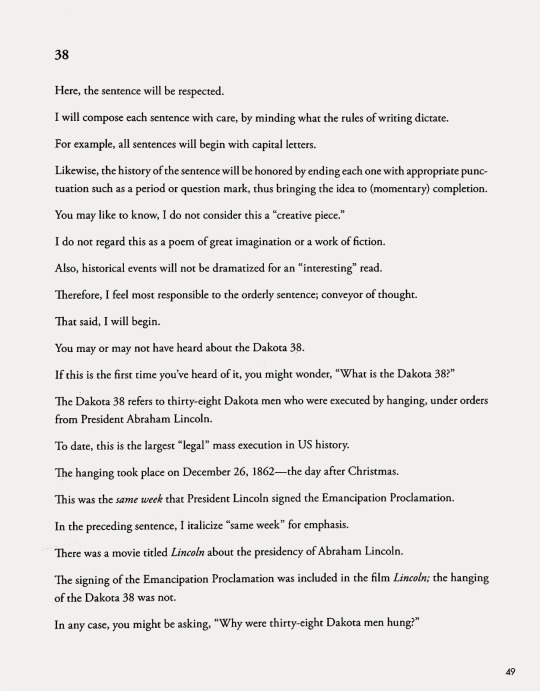
Layli Long Soldier, 38, in WHEREAS, Graywolf Press, Minneapolis, MN, 2017, p. 49-53
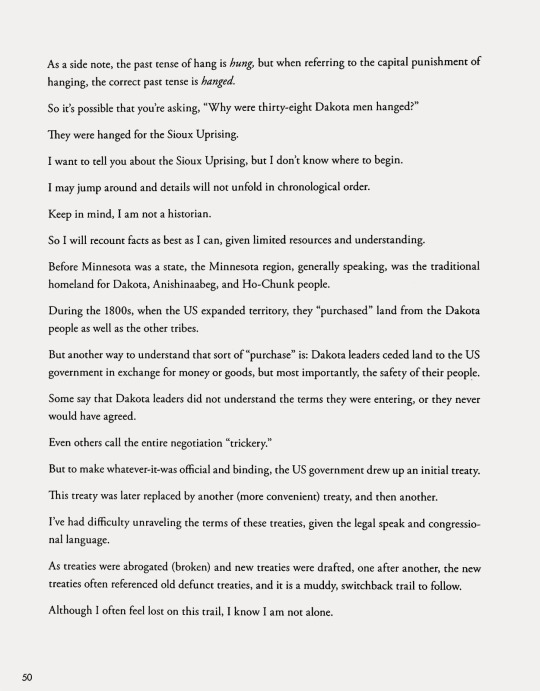

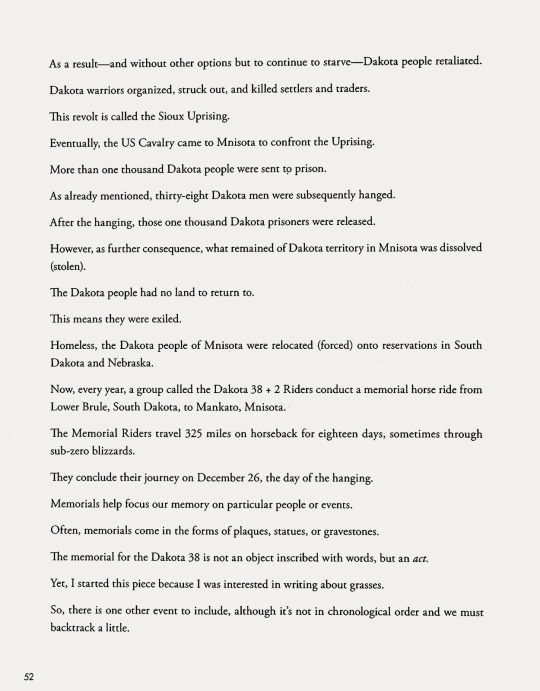
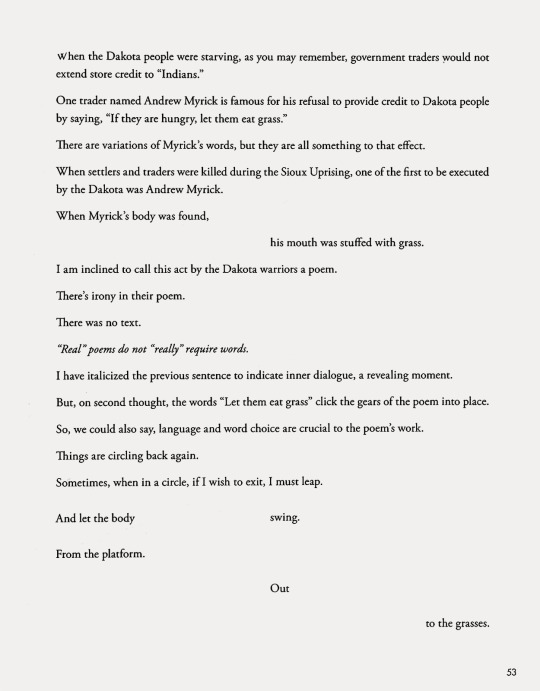
10 notes
·
View notes
Text
The total land area of all US states is around 9.14 million square km; the US has 3134 counties or county-equivalents, and in most of the country these are a pretty consistent size. there are a few weird states: Alaska has very big boroughs because of its low population, and much of the state is not organized into any borough. Virginia has a lot of independent cities (38 out of 41 in the entire country; most other states just consolidate city and county governments if a city gets very big).
Among all states east of the Mississippi, excluding Virginia, counties are about 1,423 km square (1369 if you include Virginia and count its independent cities as counties). If you include the states just across the Mississippi River, which mostly have counties about the same size as the states just to their east (here I am including Texas, Louisiana, Arkansas, Iowa, Kansas, the Dakotas, etc.; but nothing further west than the Texas/North Dakota axis), average county size rises only to 1,762 km square. Just within those states of the "nearer west," county size is about 2,220 km square, which is bigger, but not crazy bigger.
Further west, especially in states like Nevada, Utah, and California, counties get very big. Among all states west of the Texas/North Dakota line, counties average around 10,300 square km. But among all states, average county or county-equivalent size is 2,921 km square.
"County" as administrative division descends of course from English counties, which were originally feudal divisions. So how big are U.S. counties compared to their European predecessors? About the same size! England has a land area of ~130,000 km square and 48 ceremonial/historical counties (it has many more local government areas in the modern era). English counties are 2,700 km square on average, about the size of U.S. counties--in fact, maybe a little bigger than most U.S. counties. Ireland has an area of 84,421 km square (not sure what percentage of this is land) and 32 counties, for an average county size of 2,638 km square.
The U.S. state with the fewest counties is Delaware, which has just 3 (1,682 km sq each). The U.S. state with the most is Texas, with 254 counties (2664 km sq each--just a little bit bigger than Ireland!). The state with the biggest counties (again, excluding Alaska, because the unorganized borough messes things up) is Arizona, whose counties are on average 19,614 km square--just seven Arizona-sized counties would cover all of England. The state with the smallest counties is Rhode Island, whose counties average 536 km sq--at 3,144 km square in total, Rhode Island itself is smaller than the average county in fourteen states.
In terms of population, of course, the size of US counties probably varies even more wildly than their land area, but on average they compare reasonably to the local administrative divisions of other countries (some of which are third-level and some of which are second-level, depending on their size). U.S. counties have a population of about 108,000 on average. In the Republic of Ireland (so, not including the six counties of the North), counties have an average population of about 192,000. In Germany, local government areas (Kreise) have an average population of about 207,000 (though the three city-states of Berlin, Hamburg, and Bremen complicate this picture somewhat). The actual on-the-ground local government scheme in England is complex, and it is not clear to me what the modern U.S. county or German Kreise equivalent would be.
#i was going to compare france and spain also#but metropolitain france has only 94 departments#which are large in terms of population#(almost 700000 people each)#and the next functional level of government#seems to be the *much* smaller commune#of which there are tens of thousands#spain also seems to have a pretty complex diversity of local government arrangements#depending on the status of individual regions
38 notes
·
View notes
Text
I saw this back when I used to use Reddit (for animal crossing and trans+ stuff mostly), and I felt so honoured that they used my Florida flag redesign in this that I screenshotted it. But when I looked to find the original poster, they had deleted the post (likely because of negative replies, vexillology Reddit is scary).

They recreated the state flags to be more about symbolism and individuality rather than about aesthetics (which is the problem I see with a lot of over simplified state flags). All while keeping the flags that actually carry deep meaning and are beloved by the residents.
I’m not the biggest fan of Nebraska’s, Virginia’s, and Wisconsin’s, but all the others are wonderful (especially Florida’s… I will not apologize for being biased lol)
The original Reddit person’s caption:
“I kept some flags which I believe are currently great. Most of them are all over State merchandise, and people of these states carry a lot of state pride for these flags. They are:
1. Alabama
2. Alaska
3. Arizona
4. Arkansas
5. California
6. Colorado
7. lowa
8. Maryland
9. Mississippi
10. Missouri
11. New Mexico
12. Ohio, my home state! [not mine, OPs]
13. Rhode Island
14. South Carolina
15. Tennessee
16. Texas
17. Utah
18. Wyoming
19. District of Columbia [I believe you mean the Douglass Commonwealth]
20. Guam
21. The Northern Mariana Islands
22. Puerto Rico
I've switched some State’s boring Seal on a Bedsheet flags into their more popular historical ones. They are:
23. Conecticut ~ New England Flag
24. Hawaii ~ Kanaka Maoli
25. Maine ~ Original State Flag
26. Vermont ~ Green Mountain Boys Flag
27. Virginia ~ Gadsden Flag
28. West Virginia ~ Original State Flag
I've made a few tweaks to some existing flags so they look more unique / are more easily recognizable. They are:
29. Indiana ~ Golden Frame
30. New Jersey ~ Added Stripes
31. North Carolina ~ Un-Tex-ified
32. Oklahoma ~ Added Stripes
33. American Samoa ~ Added Southern Cross
I designed some using the Pan Cascade colours for the Pacific Northwest (BC will have the tree one). They are:
34. Idaho
35. Oregon
36. Washington
I borrowed some other designs which I found on here which I found beautiful. I mostly looked for flags which were designed by locals from the states that they are redesigning or included state symbols on their old flags. They are:
37. Florida [omg they chose mine!!!]
38. Georgia
39. Kansas
40. Kentucky
41. Louisiana
42. Michigan
43. Montana
44. Nevada
45. New Hampshire
46. New York
47. North Dakota [I prefer my communist flag better wajajaja]
48. Pennsylvania
49. South Dakota
50. Wisconsin
51. Virgin Islands
I left the flags currently in the process of a redesign blank, for, given the recent track record, any new flags are probably going to look amazing like Utah’s and Mississippi’s. They are:
52. Illinois [this is your reminder to vote for your new state flag if you’re from this state!!!]
53. Massachusetts [this is your reminder to vote for your new state flag if you’re from this state!!!]
54. Minnesota [this is your reminder to vote for your new state flag if you’re from this state!!!]
I kept one Seal on a Bedsheet flag to honour this horrid time in American vexillological history. That is:
55. Delaware
And lastly
56. Nebraska (idk)”
While I agree with most of the OP’s opinions, I think Nebraska’s flag would look better if it looked something like this:
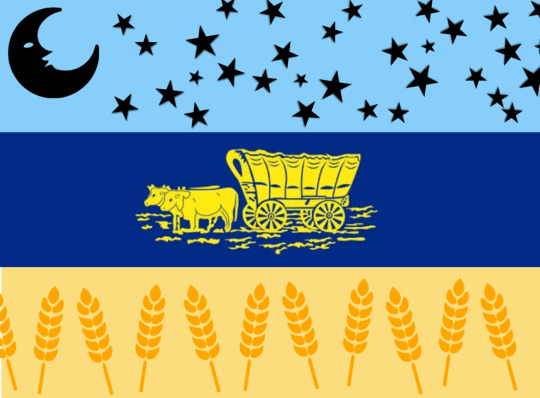
Better designed of course, I made this on Pic Collage in like 5 minutes
Im not sure about Wisconsin and Virginia, I just know I’m not the biggest fan of either (since Virginia’s flag has a separate meaning and Wisconsin’s is just bland.
Let me know what you think!
And if you’re the OP of this, please let me know, I like your choices!!
#usa#united states#state flags#alabama#alaska#arizona#arkansas#california#colorado#conecticut#delaware#florida#georgia#hawaii#idaho#illinois#indiana#iowa#kansas#kentucky#lousiana#maine#maryland#massachusetts#michigan#minnesota#mississippi#missouri#montana#nebraska
17 notes
·
View notes
Text
jrwi pd season 2 ending spoilers? (but also no spoilers for me i just finished ep 38)
see dude i. i know ashe is coming back. it’s genuinely impossible for her not to because of all the buildup, the fact yakko did an ashe cosplay, etc.
but part of my brain is almost sad about it. i think it’s more abt the season ending and the fact that i’ll have to wait for season 3 but also. season 2 was a story about grief. it was about separation and it was about having to come together in the worst of times to save what matters most. the mystery surrounding ashe and the trickster and mark and david and bell tech and vyncent’s world and dakota’s past and william’s future,, all of it has been insane to experience over the course of two ish months. and idk i’m just. not ready, i guess, for this to end </3 like. with ashe back the group is gonna be whole again and they’re gonna get the peace they so greatly deserve but it’s gonna be left behind. they’re not gonna be flying a car chasing after an otherworldly lich anymore. there’s not gonna be vyncent jumping off s building for william, there’s not gonna be cantrip betting against him kissing vyncent. there’s not even gonna be a cantrip.
aughh i just. im gonna be stuck perpetually missing them all until season 3 now. i’ve never been so hyperfixated and emotionally attached to a piece of media before, except maybe 2020. this gay ass fucking podcast is so fucking evil it won’t ever leave my brain 👍
#vixen rambles#jrwi pd#posts made by a wholly stable and balanced person with no heartcrushing attachments to any of these characters
8 notes
·
View notes
Text
On This Day In History
December 26th, 1862: The largest mass execution in U.S. history takes place. 38 Native Americans were publicly hanged in Mankato, Minnesota, as part of the Dakota War of 1862.
#history#world history#dakota history#united states history#usa history#minnesota#indigenous history#dakota war of 1862#tw racism#racism#tw death#death#tw hanging#hanging#anti indigenous racism#american imperialism
75 notes
·
View notes